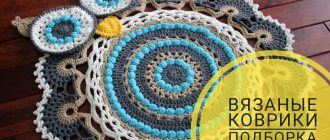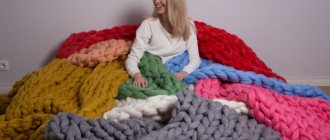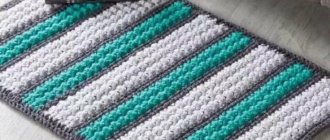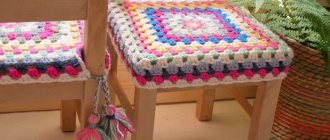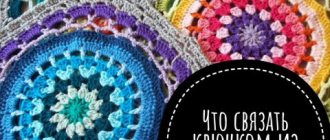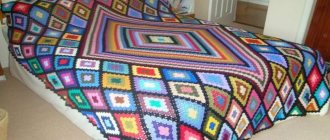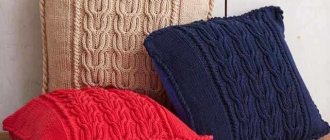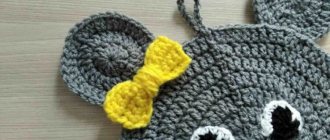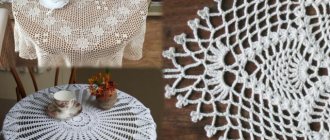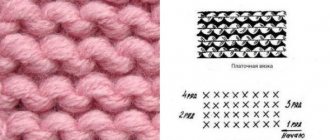Square cover for stool
Dimensions: 50cm by 50cm.
We will need:
- yarn, 100% acrylic, color selection according to your wishes - only about 100g;
- hook No. 2.5.
Description
We begin to knit a cover for a stool by crocheting a chain of 5 VPs. We close it into a ring with a connecting post. Next, we knit the cover according to the instructions in the pattern:
- 1st row: 3 VP lifting, 2 double crochets in the 1st VP lifting, 2 VP, * 3 double crochet. with nak. in the ring, 2 VP* - from * to * repeat twice. Only 4 times. Complete the row of connections. column.
Next, knit according to the pattern for the 5th row. inclusive.
Change yarn colors randomly in each new row. Crochet 9 squares and connect them together in the last row.
Tie the cover on the stool around the perimeter in a circle with 1 post next to it with capes. Thread an elastic band or cord between the double crochets.
How to choose fabric
Both for furniture upholstery and chair covers, it is necessary to select durable, easy-to-clean fabrics. Wool, wool mixture and viscose are not suitable for accessories. Velor and velvet are not the best solution, as such fabrics wear out quickly and are difficult to clean due to lint. Craftswomen prefer to work with:
- Cotton fabrics such as satin, twill, jeans, gabardine. Their advantage is their natural composition. The downside is increased moisture absorption.
- Flax. It can be canvas or linen. Plus - wear resistance and self-cleaning ability. The downside is that it wrinkles quickly and is only suitable for designs in the Provence style.
- Silk: brocade, silk gabardine, satin, crepe-satin. Advantages: resistance to moisture, abrasion, fading, shape retention. Disadvantage: slippery surface.
- Synthetic fabrics for upholstery. More often - with microfiber, less often - with flock. Plus - they practically do not get dirty, which simplifies the care of the accessory. The downside is the fragility. The service life of microfiber and flock covers is a maximum of 5 years, after which it will be necessary to sew new covers.
Red stool cover with embroidery
Size: Ø28cm.
We will need:
- yarn, 100% cotton, 100g per 392m, red melange – 100g;
- the same, red – 20g;
- some white and orange yarn;
- hook No.3.
Description
We begin to knit a cover for a stool by crocheting a chain of 2 VPs using melange yarn. We close them in a circle SSt. Next we knit:
- 1st row: 1 single rise, 5 sc in the resulting ring. Finish the row using conn. Art.;
- 2p.: 1 VP lifting, 1 RLS in VP lifting, * 2 SC in the next row. RLS previous R. from hook* – from * to* repeat 4 times, 6 times in total. Finish the row using conn. Art.;
- from 3rd r. on the 28th row: perform RLS, evenly increasing their number in each row. on 6 columns. Every r. finish SS. Cut the thread;
- RUR 29: connect red yarn, 1 st. lifting point, 1 sc in the previous sc. R. from the hook. Finish the row using conn. Art.;
- 30r.: 1 c. p. rise, 1 sc in the sc of the previous row. from the hook, SST;
- 31r.: 3 c. p. rise, 1 sc in the sc of the previous row. from the hook, SST;
- 32r.: 3 c. p. rise, 1 sc in the sc of the previous row. from the hook, SST.
Assembly and finishing
We carry out embroidery according to the pattern using a stem stitch. Thread the elastic band through the double crochet row 32.
Crochet chair cover with diagrams and videos for beginners
Decorating your home is one of the main concerns of women, so sometimes such an endeavor ends up being very expensive.
Especially creative people begin to decorate their rooms, walls, sofas, shelves. And when you enter such a house, you are surprised at how diverse the decorative elements are. Some needlewomen embroider unique paintings, which they then hang on the wall. They can sew original curtains and tablecloths. But not only the walls need decorations, but also the furniture, for example, you can decorate stools. Some sew beautiful pillows, but a knitted cape will turn out to be a very original decorative element. Those who are just starting to learn how to work with crochet should not worry that nothing will work out. Let's try to crochet a chair cover with the patterns proposed below, which will help every beginner cope with this task and even learn how to make different patterns. Such covers can be so varied that sometimes it is possible to see a whole range of colors in the kitchen. Another plus is that when you learn how to knit such things, you can make a gift set.
Brown stool cover
Size: Ø28cm.
We will need:
- yarn, 100% cotton, 100g per 392m, brown melange – 100g;
- the same, gray – 20g;
- some white, red and orange yarn;
- hook No.3.
Description
We begin to knit a cover for a stool, like the previous knitted covers, by crocheting a chain of 2 VPs with melange yarn. We close them in a circle SSt. Next we knit:
- 1st row: 1 single rise, 5 sc in the resulting ring. Finish the row using conn. Art.;
- 2p.: 1 VP lift, 1 StBN in VP lift, * 2 StBN in the next. StBN previous R. from kr-chka* – from * to* repeat 4 times, 6 times in total. Finish the row using conn. Art.;
- from 3rd r. on the 28th row: perform RLS, evenly increasing their number in each row. on 6 columns. Every r. finish SS. Cut the thread;
- RUR 29: connect red yarn, 1 st. lifting point, 1 sc in the previous sc. R. from the hook. Finish the row using conn. Art.;
- 30r.: 1 c. p. rise, 1 stbn in sc of the previous row. from kr-chka, SST;
- 31r.: 3 c. p. rise, 1 stbn in sc of the previous row. from kr-chka, SST;
- 32r.: 3 c. p. rise, 1 stbn in sc of the previous row. from kr-chka, SST.
Assembly and finishing
We carry out embroidery according to the pattern using a stem stitch. Thread the elastic band through the double crochet row 32.
Varieties
The cover performs not only a decorative function. With the help of such an accessory, designers solve several problems:
- preserve rare furniture and hide its defects;
- focus on individual interior details;
- decorate the room according to a specific holiday theme.
Based on appearance and functionality, accessories are divided into three groups:
- Universal. These are unique capes that can cover either the entire chair or just its seat. The basis for them must be without armrests. Capes are attached with ties, elastic bands or buttons.
- Half covers. They do not completely cover the chair. They are sewn from translucent fabric, skillfully emphasizing the design features of the furniture itself.
- Luxury class. Models with bright decorative elements and drapery. They are sewn for special occasions.
Case made of motifs
Dimensions: 27cm by 27cm.
We will need:
- yarn, 100% cotton, 150g per 225m – white, lilac, violet colors – 150g each;
- hook No. 3.5.
Patterns:
- for the main motive we dial 2 air. p. and crochet from the 1st r. on the 14th r. scheme;
- for leaves we collect 2 air. p. and crochet from the 1st to the 4th r. cx.
Description
We need to connect nine motifs along cx. and connect them into a common square canvas. It is advisable to tie the finished product, like all stool covers, in a circle. We crochet 16 rows of sc, alternating colors:
- from 1st to 3rd r. – purple yarn;
- from 4th to 6th r. – white;
- from 7th to 9th p.m. – purple;
- from 10th to 12th p.m. – lilac;
- from 13th to 15th r. – white;
- 16 rubles - purple.
We knit 8 leaves according to the pattern, alternating the colors of the threads.
You can decorate the covers with tassels, ruffles, etc. We suggest crocheting a chain of VP with a length of 32 cm using three threads (lilac + white + purple). Insert the knitted cord into one side of the cover and sew a leaf on each corner. For the remaining parties we repeat the algorithm.
Tips for beginners
Experienced craftsmen who have been knitting for a long time and know many tricks that will help you spend less money and time on a product and at the same time make it as beautiful and durable as possible. What should a beginner pay attention to?
A set of identical covers for stools, made by yourself.
The basis
To preserve the finished product for as long as possible, it should be based on a dense base. The lining fabric will help not to lose the beauty of its appearance over time and will not allow it to spread out and become shapeless.
Knitted covers for stools in the same style.
Leftover yarn
To create one cape, it is not necessary to buy new skeins of thread. Use the remains in a wide variety of variations and, perhaps, such a work of abstract art will become the most original detail of your home interior.
Knitted round seat cover.
Border
If a novice needlewoman miscalculates in determining the size of the future product and misses by a smaller margin, such a cape can be modified by tying several rows of borders.
Openwork covers
The covers have a diameter of 28cm.
To knit openwork covers we will need:
- yarn of any composition, preferably with the addition of synthetics;
- hook according to the thickness of the threads.
Description
We begin knitting covers by forming a loop. To do this, wind the yarn around your finger, forming a ring. We knit 3 air into it. lifting loops and 31 StS1N. We complete the row of connections. stlb, tighten the end of the thread. Next, we continue crocheting according to the pattern up to 15 rubles.
Separately, we make a cord from VP and insert it into the 14th row of the seat, then tighten it.
Starting to crochet a seat
Cast on ten gentle loops. We do not tighten the first twist in order to close the ring of the connecting loop into it. Next, we collect three handmade ears, which will serve as the first column.
They add twenty-three more columns in the middle, resulting in twenty-four. We reach the end of the row, and join the third loop with an end ring.
Popcorn covers
We will need:
- yarn, 100% acrylic, thick, color - according to your wishes;
- hook according to the thickness of the yarn.
Description
We will knit according to the pattern, alternating colors of our choice. We start by setting a chain of 8 chains.
We close it in the SSt ring and then knit:
- 1st row: 3 single lifts, 4 dc in the ring.
To form the 1st cone, we take the circle out of the working stitch and first insert it into the 3rd stitch of the lift, then return to the working stitch. loop. We stretch it through the 1st. We have a cone made of columns.
This pattern is called "popcorn".
Then *4 chain stitches, from ring 5 DC, insert a crochet into the top of the 1st stitch, then into a working stitch, pull it through the top of the 1st stitch*. Repeat from * to * twice more. We finish row 4 in/p, sl st to the top of the 1st cone.
For the 2nd r. We do 3 high-rise lifts. In this row, from each arch we knit 2 cones, between which there are 4 v/p, on the sides of the square we knit 3 v/p. The first bump consists of lifting loops and 4 dc, all other bumps are made of 5 dc.
At 3 p.m. from the corner arches we knit 2 cones, between which there are 4 v/p. On the sides of the square there are 3 v/p, cones from the arch, 3 v/p. We complete the row of SST at the top of the 1st cone.
We continue to work on this principle. From the corner arches we knit 2 cones, between them - 4 v/p. On the sides we make one bump from each arch after 3 points.
Having finished making the seat to the desired size, we knit two rows of cones without any increases at the corners; in the last row, knit the cones through 2 stitches. We get a narrowing of the cover, which will allow you to fix it on the stool after stretching it.
Cutting Basics
To know how to sew a chair cover, you need to take preliminary measurements. First, measure the overall height of the chair from the floor to the top of the back. The next stage is measuring the width and height of the back itself. Even if it is not tightly adjacent to the seat, it is clearly measured at the extreme points. Measure the seat in the same way. The last stage is measuring the legs and the distance between them.
For universal floor covers you will need 2-3 meters of fabric. If it is a small cape, then 1.5 meters of material is enough. When cutting, be sure to take into account the type of fabric. For example, heavy materials require exclusively fractional layout of the pattern. In this case, they approach the design of the ritual (the side parts covering the legs) very carefully. If the pattern is laid out along the lobar, as shown in the figure in pos. 2, then the ritual will bend under the seat.
If supplex is taken as a basis, then there will be no such drawback. In this case, the apron and the ritual are cut in the same direction. To get soft folds, make a diagonal layout, but in this case the consumption increases (item 3).
Light natural fabrics require separate cutting of the skirt. The flounces at the bottom of the case look beautiful in crepe-satin, gabardine, brocade, and silk. Cut out the accessory according to the arrows in pos. 4
The measurements are transferred to paper and patterns are made. When laying them out on the fabric, do not forget to make 3 cm allowances for seams, the depth of the parts and the shrinkage of the material. For beginners who do not yet know how to make a chair cover so that it immediately “sits” on the base, it is better to use the direct fitting method. The fabric is thrown over the chair and pinned along the contour.
For sewing you will need:
- tracing paper or graph paper;
- centimeter and ruler;
- pencil or chalk;
- tailor's scissors (preferably zigzag);
- tailor's pins
- non-woven fabric for sealing.
Simple Garter Stitch Poncho with Button
Check out this poncho. It is knitted in simple garter stitch. Garter stitch is soft, loose and hugs the body perfectly. This poncho feels like a pullover.
This pattern is good in itself and does not require any braids or additional pattern. Very simple knitting, accessible even to beginners.
This poncho can be worn as a separate item, but can also be used as a source for further refinement. In my opinion, the poncho looks untied. There is not enough finishing of the edge of the product.
